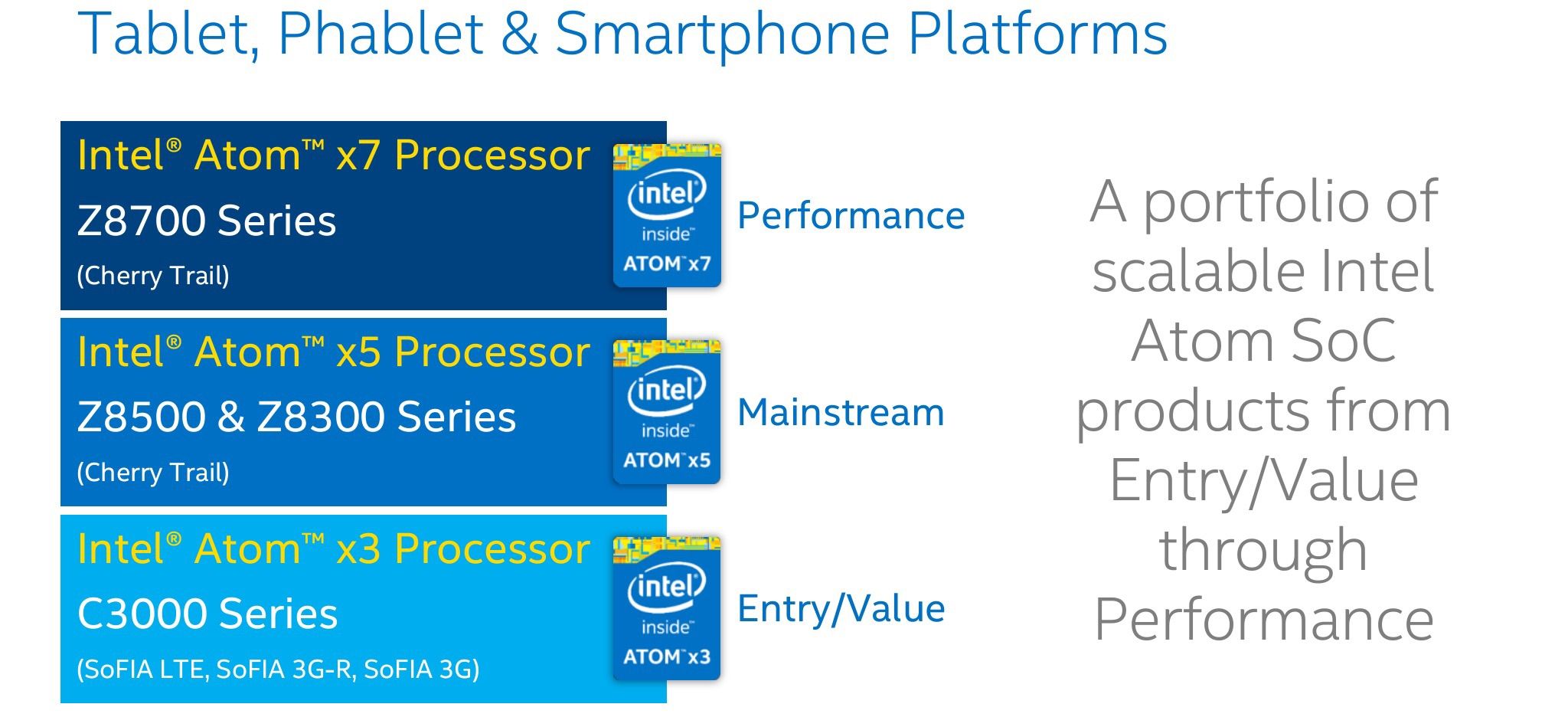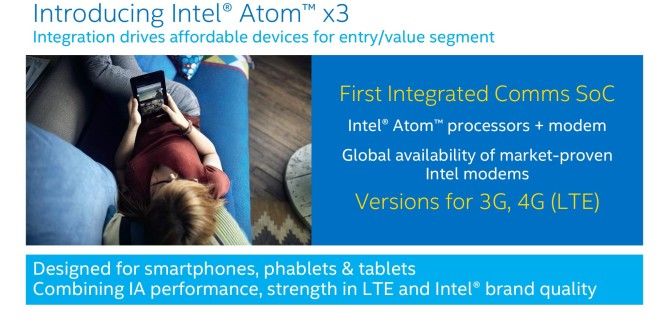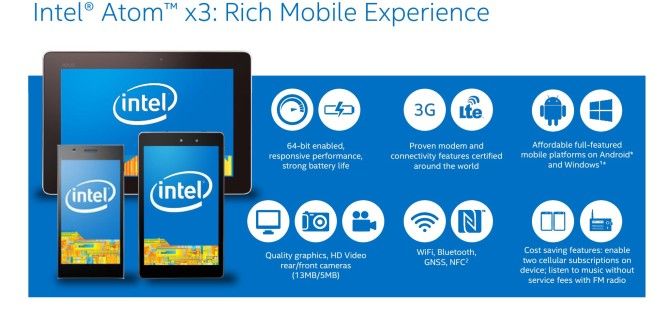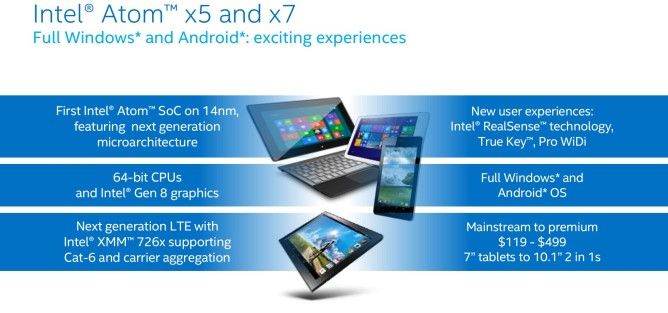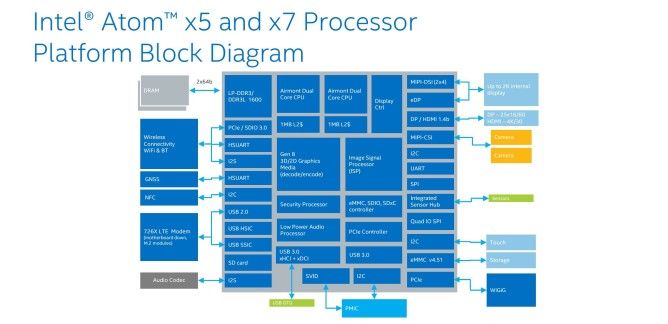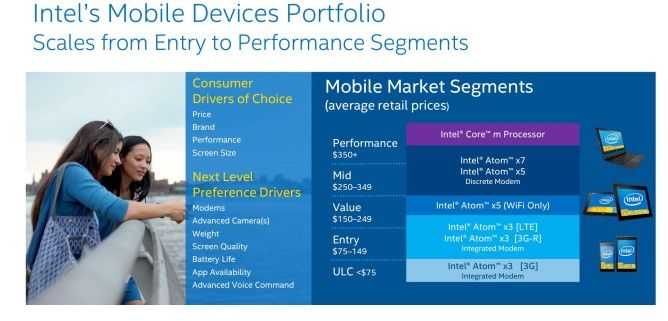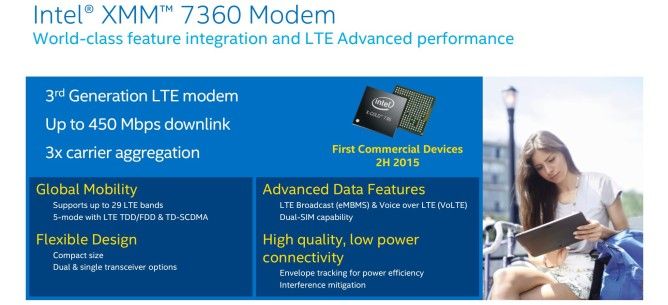This week at MWC, Intel revealed its 2015 and 2016 mobile chipset lineup, as well as the fact that the company is adopting a similar naming scheme to its Core line of processors with these new chips. They've been dubbed x3, x5, and x7, and as with the Core processors, bigger is generally better.
Intel has long been something of a dark horse in the mobile industry. The company has seen negligible penetration in smartphones to date (though not none) and competes almost exclusively in the low to mid-range segment in Android tablets. Of course, as the ultraportable market changes and small, super-thin laptops and convertibles become more common, Intel is swooping in with design wins left and right, keeping the likes of Qualcomm, NVIDIA, MediaTek, and Samsung out of a lucrative market.
The Ultrabook swing was a huge help to Intel, a beacon of hope as the world's top chipmaker failed to break into mobile. While Intel struggled to foist itself into a viable position in the consumer tablet market, the resurgent laptop cemented Intel's strong relationships with OEMs like Dell, Acer, ASUS, Lenovo, Samsung, HP, and others. Who have those OEMs come to for their most recent Android tablets? Not counting Samsung, the answer has almost universally been Intel.
In fact, it's actually getting quite difficult to find new Android tablets that aren't running with Intel processors - not that there aren't holdouts like Sony, Google, and Samsung. Today's announcement sees Intel marching forward with its plans for tablet, convertible, and Ultrabook world domination, as well as signaling that it's not quite giving up on phones just yet.
The Atom x3 processor (note that these aren't 'Core' processors - that level starts at the Core M tier, above x7) is Intel's first fully-integrated LTE system-on-a-chip, a major milestone. The x3 was made possible in large part through Intel's acquisition of the SoFIA platform, on which the x3 is based, with the exception of the Intel application processors.
These chips are aimed directly at the budget market where Intel has seen success in tablets - don't expect to find them in major smartphones unless they're majorly cheap. x3 comes in three flavors to start: 3G, 3G-R, and LTE (the top-tier LTE version will also ship as Wi-Fi only for tablets). The 3G-R and LTE models get quad-core 64-bit Atom processors (Intel isn't providing specifics) and varying levels of Mali graphics with SoFIA integrated modems. The entry-level 3G is a dual-core.
x5 and x7 are more interesting, but don't hold your breath on phone applications. While there's nothing exactly stopping these bleeding-edge 14nm 64-bit Cherry Trail processors from being put in a smartphone, their lack of integrated cellular modems simply won't make them attractive to most phone manufacturers. Intel is touting its new XMM 7360 LTE modem alongside x5 and x7, and while it is a discrete chip, it's at near feature parity with Qualcomm's current offerings. The aside, of course, is that we have no idea what power consumption, efficiency, and general performance is like compared to Qualcomm's latest, and I doubt Intel's chomping at the bit to tell us. The x5 and x7 do feature brand-new integrated wireless (Wi-Fi, BT, FM, etc.) chips, NFC controllers, and an Intel-developed location chip.
Wi-Fi only versions of x5 and x7 will be in commercially available devices in the first half of the year (Intel didn't say when x3 would launch), which is likely to only increase Intel's sphere of influence in the tablet world. How fast are x5 and x7? If your guess was "Intel isn't saying," you win! Intel hasn't actually announced any specific x5 and x7 models, so specifications are pretty scarce. Intel's basic outline of the x5/x7 platform seems to suggest all the chipsets will get quad-core Airmont 14nm processors, though I wouldn't be surprised if we saw a dual-core setup at the cheap end of the parts bin. 8th-gen integrated Intel GPUs will push the pixels on x5 and x7 hardware with, as you may have guessed, precious few details as to what exactly that means for performance. Intel boasts benchmark gains in Open GL of up to 100% over older Atoms, and 50% in applications like 3DMark. How the old chip performed is, of course, not elaborated on.
Intel envisions x5 and x7 parts will find their ways into devices retailing anywhere from $200 to $400+, which will put those Airmont cores among slightly more rarified air than their x3 cousins, which Intel relegates to the sub-$200 market.
Intel's processor size advantage over Qualcomm basically ensures its continued rise in the tablet space through 2015. Qualcomm 14nm parts aren't expected in quantity until next year, though there is some speculation that limited 14nm runs of the San Diego firm's next-gen core may make it into production by year's end. For Qualcomm, though, the tablet space already seems lost - Intel is competing in large part with MediaTek and other budget processor companies at the low end, where an integrated cellular radio isn't a dealbreaker. At the high end, Samsung is pushing Exynos, and Amazon remains Qualcomm's last truly major tablet partner. Intel has competed aggressively on price and sell-through assistance with its partners to basically wrap up the Android tablet market - Intel is currently the largest independent vendor of chipsets in tablets, though Apple still manages to ship more iPads with its own chips overall than Intel does with all of its partners around the world.
x5 and x7, though, show that we're basically dealing with the same problems Intel has for years: the lack of a solid integrated cellular solution and mediocre graphics performance (though that is changing). Power consumption aside (which Intel says will be "competitive" on these new chips), it's clear Intel still has a winding road ahead of it before it can take on Qualcomm in its home space - the smartphone. As the tablet market shows signs of contraction, it also seems unlikely that 2015 will be especially lucrative for Intel's mobile business, which has lost money every year it has operated. Intel will likely keep losing money here as it hones and streamlines its mobile portfolio, though x5 and x7's Airmont underpinnings are finally seeing Intel's architectural roadmap align a bit more. Regardless, it's clear the desktop CPU market's sleeping giant is awake, and Intel doesn't plan on going back to bed any time soon.

